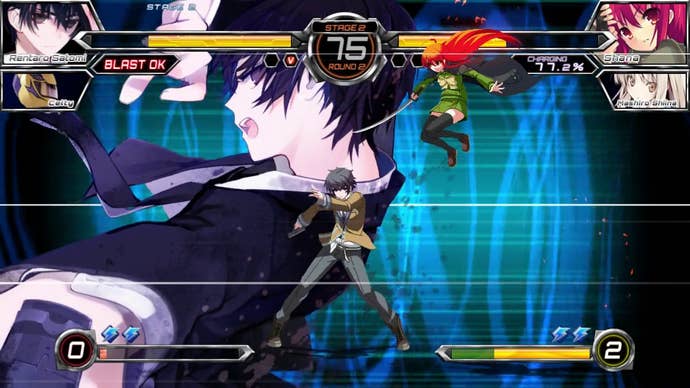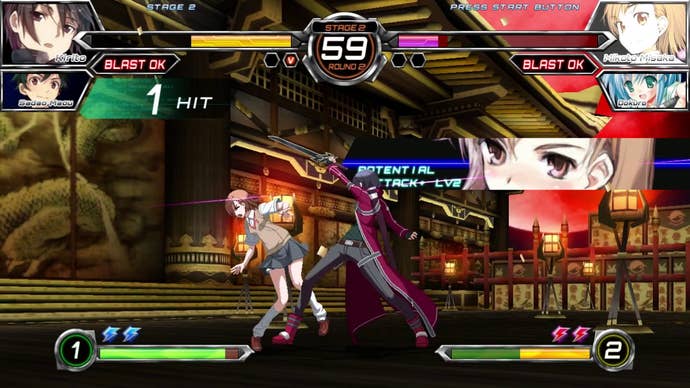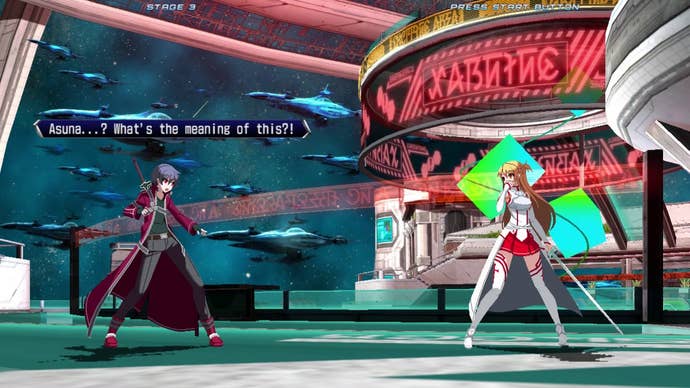Dengeki Bunko Fighting Climax PS3 Review: Fanservice Fighting
Anime and light novel fans may find fighting fun, but Dengeki Bunko doesn't offer much for everyone else.
This article first appeared on USgamer, a partner publication of VG247. Some content, such as this article, has been migrated to VG247 for posterity after USgamer's closure - but it has not been edited or further vetted by the VG247 team.
Dengeki Bunko Fighting Climax is an interesting crossover project. The title brings together characters from various light novels published on the Dengeki Bunko imprint and magazine owned by ASCII Media Works. Light novels under this imprint are all aimed at young men and many of them tend to feature similar plots and character tropes. If you're an avid anime watcher, you've probably seen more than a few series based on light novels. Chosen ones, tsundere love interests, and special schools abound.

Dengeki Bunko Fighting Climax brings some of the more popular characters from the imprint together in a single fighting game. That means you have characters from Sword Art Online, Durarara, Toradora, Black Bullet, A Certain Scientific Railgun, and Oreimo dueling it out as 2D sprites on 3D backgrounds. Oddly enough, the 3D backgrounds the fights take place on are pulled from various Sega games like Sonic the Hedgehog, Phantasy Star Online 2, and Valkyria Chronicles, making an odd juxtaposition. Yes, Sega is the title's publisher, but there's only two playable Sega characters and they're both unlockable, so it seems odd to not use backgrounds related to the various series.
For a crossover game, the roster is the primary strength and in Dengeki Bunko Fighting Climax that roster features 14 playable characters. 12 of them are pulled from the light novels and they represent the most popular faces from their various stories, not necessarily the main characters. That leads to some odd choices here and there. Sword Art Online's Kirito and Asuna, Shakugan no Shana's Shana, A Certain Scientific Railgun's Railgun, or Black Bullet's Rentaro makes sense as they're the primary characters of their worlds, but other choices like Durarara's Shizuo, Strike the Blood's Yukina, Accel World's Kuroyukihime, or The Irregular at Magic High School's Miyuki were clearly made from a popularity standpoint.
The final two characters are Akira from Virtua Fighter and Selvaria from Valkyria Chronicles, standing as the only two Sega characters of the roster. Honestly, the roster feels a bit slim, even though the 14 playable characters line up well with other first-outing Japanese fighting games like Persona 4 Arena and Guilty Gear Xrd. The crossover nature makes me mentally compare Fighting Climax to other crossover games like Super Smash Bros (55 characters), Marvel vs. Capcom 3 (36 characters), or even PlayStation All-Stars Battle Royale (20 characters), which isn't fair given the fact that those are all 3D titles.


Despite that, tandem developers Ecole Software and French Bread - the folks behind Melty Blood and Under Night In-Birth - probably realized that the roster was a bit slim in the fanservice department, so there's also 23 assist characters. This allows them to add many of the protagonists, like Tatsuya from The Irregular at Magic High School, Toma from A Certain Magical Index, or Kojou Akatsuki from Strike the Blood. It also gives them room to throw in some smaller characters like Boogiepop from Boogiepop Phantom, Kino from Kino's Journey, or Holo from Spice & Wolf.
If the last three paragraphs caused your eyes to glaze over, then you are not the intended audience for this game. Seeing these characters together on your television is the point, one that Ecole and French Bread understand. Fighting Climax benefits from the amount of time spent on reinforcing the interactions between all these various characters. There's a good amount of dialog depending on who's fighting whom and the single-player Dream Duel mode is all about matching your chosen character up against six other fighters and seeing their conversations before the fight. If you want to know what Yukina from Strike the Blood would say to Toradora's Taiga Aisaka, now you have a chance to find out.


As a fighting game, Fighting Climax slots in somewhere in-between Super Smash Bros and Persona 4 Arena. When it comes to command inputs, it's not even as mechanically complex as what I remember of the Melty Blood titles. If you can perform quarter-circle forward or backwards motions on a D-Pad or joystick, you're in on the ground floor. If you can extend that to half-circle motions, you can perform the game's versions of super moves, Climax Arts. Combined with three attack buttons and the single support call button, you have a fighting game that feels easy to get into.
The Persona 4 Arena comparison is apt, because on top of this, Ecole and French Bread have layered a number of other systems, include recoveries, quick combos, impact skills, EX moves, the Blast gauge, and the Trump Card system. Together, there's still a good bit of strategy to the game. It's not on the technical high-end as some fighting games, but it's also not bereft of complexity. There's no tutorial though, which seems an odd omission given the game's focus on simpler combat.
Unfortunately, the smaller roster and the simpler fighting system means the characters overall feel quite flat when it comes to variety. There are some characters that stand out - Ro-Kyu-Bu's Tomoka has some very interesting tactics and may be my personal nemesis - but otherwise many feel quite similar. Dengeki Bunko Fighting Climax isn't bad, it just feels like there could be more. This is the first step in something bigger better. Japanese players are getting the upgraded version, Dengeki Bunko Fighting Climax Ignition in December, but I'm unsure if the changes are enough (4 new characters, a second assist slot, and the new Ignition system).

The game is filled out with basic online modes (the netplay seemed fine in my tests), the standard Training mode, a bog standard single-player story, and Challenge modes like Score Attack and Survival. Fighting earns you an in-game currency, CP, which you can use to purchase more character colors, voice sound tests, and various customization options for online play, like titles and player icons. There's also character bios, a soundtrack player, and a gallery of the original light novel covers featuring the major characters.
It bears repeating: if you're an avid anime fan, Dengeki Bunko Fighting Climax may have enough to keep you coming back. If you love these characters in particular, it may be all the fighting action you need. If you're not and you're just looking for a new fighting game experience, I'd recommend something with a bit more meat to it, like Guilty Gear Xrd or Persona 4 Arena Ultimax. Dengeki Bunko comes in at a cheaper $39.99, but that's still $10 more than Ultimax's current asking price. All told, the game is a solid effort, but an unspectacular one given the developer's pedigree.

Lasting AppealYou'd have to be really into unlocking colors and the Dream Duel mode to stay with it for a long time.
VisualsThe 2D visuals look good, slotting in the same class as Persona 4 Arena.
ConclusionIf you're a big fan of these light novel characters or the anime they've been in, Dengeki Bunko Fighting Climax might be your jam. If not, this fighter is accessible, but that accessibility makes many characters on the small roster feel the same. A solid effort, but there are better 2D fighters out there.









